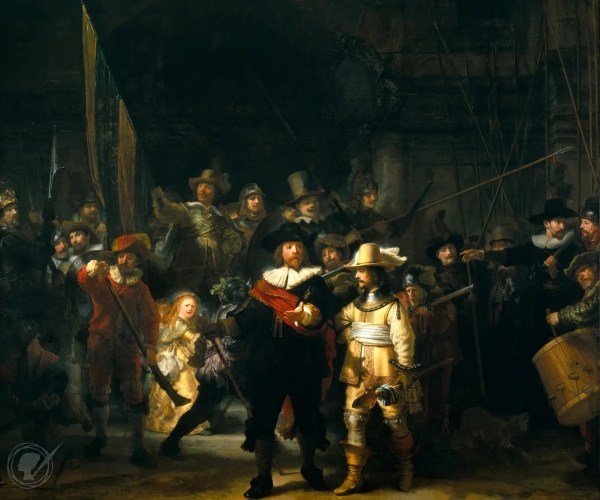The NightWatch
"The Night Watch" by Rembrandt van Rijn is not just a painting; it's a theatrical spectacle frozen in time, capturing a moment of dynamic action unlike any other in the 17th century Dutch art. Created in 1642, this masterpiece stands out in Rembrandt's oeuvre for its colossal size and the dramatic use of light and shadow, known as chiaroscuro, a technique that Rembrandt mastered like no other. The painting's official title is "Militia Company of District II under the Command of Captain Frans Banninck Cocq," but it's popularly known as "The Night Watch" due to the dark varnish that gave the impression of a nocturnal scene, a misconception corrected only after a cleaning in the 1940s.
At its core, "The Night Watch" is a group portrait of a city militia, but Rembrandt elevates this conventional commission to an extraordinary level. He breaks away from the static formality typical of group portraits of the time. Instead, he introduces movement, drama, and a sense of immediacy. The central figures, Captain Frans Banninck Cocq and his lieutenant, Willem van Ruytenburch, are bathed in a heavenly beam of light, emphasizing their leadership roles. Around them, the militia members are depicted in various states of action, each character contributing to a narrative that extends beyond the canvas.
Rembrandt's genius lies in his ability to blend realism with theatricality. The figures are rendered with meticulous detail, their expressions and postures conveying a range of emotions and stories. Yet, the overall composition, with its dramatic use of light, gives the scene an almost dreamlike quality. The play of light not only highlights certain characters but also creates a sense of depth and volume, guiding the viewer's eye through the complex tableau.
Furthermore, "The Night Watch" is a testament to Rembrandt's innovative spirit. He experiments with perspective, placing some figures in the foreground and others receding into the shadowy background, a technique that adds a three-dimensional quality to the painting. The chiaroscuro creates a stark contrast between light and dark, imbuing the scene with a dramatic tension that was revolutionary for its time.
In conclusion, "The Night Watch" is more than a mere portrait of a city militia; it's a celebration of life, movement, and the play of light and shadow. Rembrandt's masterpiece not only captures a moment in Dutch history but also embodies the artistic spirit of the Baroque period, pushing the boundaries of conventional portraiture and setting a new standard for generations of artists to come."







No Comments Yet...